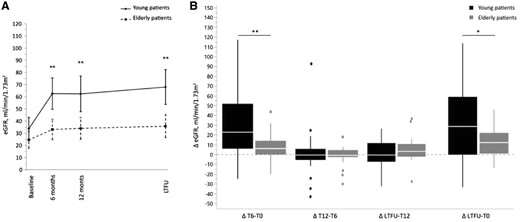-
PDF
- Split View
-
Views
-
Cite
Cite
Alvise Berti, Mara Felicetti, Sara Monti, Augusta Ortolan, Roberto Padoan, Giuliano Brunori, Roberto Bortolotti, Roberto Caporali, Carlomarurizio Montecucco, Franco Schiavon, Giuseppe Paolazzi, 128. DISEASE AND TREATMENT-RELATED MORBIDITY AND COMPLICATIONS IN YOUNG AND ELDERLY PATIENTS WITH ANCA-ASSOCIATED VASCULITIS, Rheumatology, Volume 58, Issue Supplement_2, March 2019, kez059.005, https://doi.org/10.1093/rheumatology/kez059.005
Close - Share Icon Share
Background: Advancing age may be a risk factor for morbidity in anti-neutrophil cytoplasmic antibody (ANCA)-associated vasculitis (AAV). We aimed to compare the rates and better characterize the type of disease- and treatment-related complications affecting young and elderly patients with AAV.
Methods: All new cases of granulomatosis with polyangiits or microscopic polyangiitis diagnosed between 2000 and 2016 in three referral centers in Northern Italy were included. Patients were stratified by age into young or elderly (</⩾65 years old). Data were collected from time of diagnosis until end of follow-up, with scheduled annual visits or additional visits in case of relapse or complication requiring hospitalization.
Results: Of 141 patients included, 99 were young and 42 elderly at the time of AAV diagnosis. Median follow-up was 58.0 months (25-75% IQR, 31.0-60.0) in young and 48.0 months (25- 75% IQR, 23.25-60.0) in elderly patients (p > 0.05). Overall, total chronic damage assessed by Vasculitis Damage Index (VDI) significantly increased in elderly patients compared to young ones during follow-up hypertension, heart failure, ischemic cardiovascular complications, diabetes, and malignancy) accumulated over time when analyzed singularly, no difference between the two age groups was observed (p > 0.05). Sixty-three (44.7%) patients had acute kidney injury due to AAV-glomerulonephritis at diagnosis, 37 were young and 26 were elderly. In these patients, renal function recovery in the first 6 months was significantly lower for elderly (median ΔeGFR (25-75%IQR), 5.3 (0.4-14) ml/min/1.73m2) compared to young patients (22.8 (5.9-52.1) ml/min/1.73m2, p = 0.008) while on induction treatment (Figure 1). Stratification for ANCA status (MPO-ANCA+ versus PR3-ANCA+), did not change these results. Despite similar immunosuppressive therapy approaches and relapse rates, elderly patients had a higher rate of severe infections compared to younger patients (OR 2.1, 95% CIs: 1.1-4.4, p = 0.043).
Conclusion: Our findings indicate that elderly patients had higher susceptibility to morbidity related to vasculitis or its treatment than younger patients, particularly to worst renal function recovery and higher infection rate.

Disclosures: None




Comments